Walker J. Facies models, Canada, 1992
Подождите немного. Документ загружается.

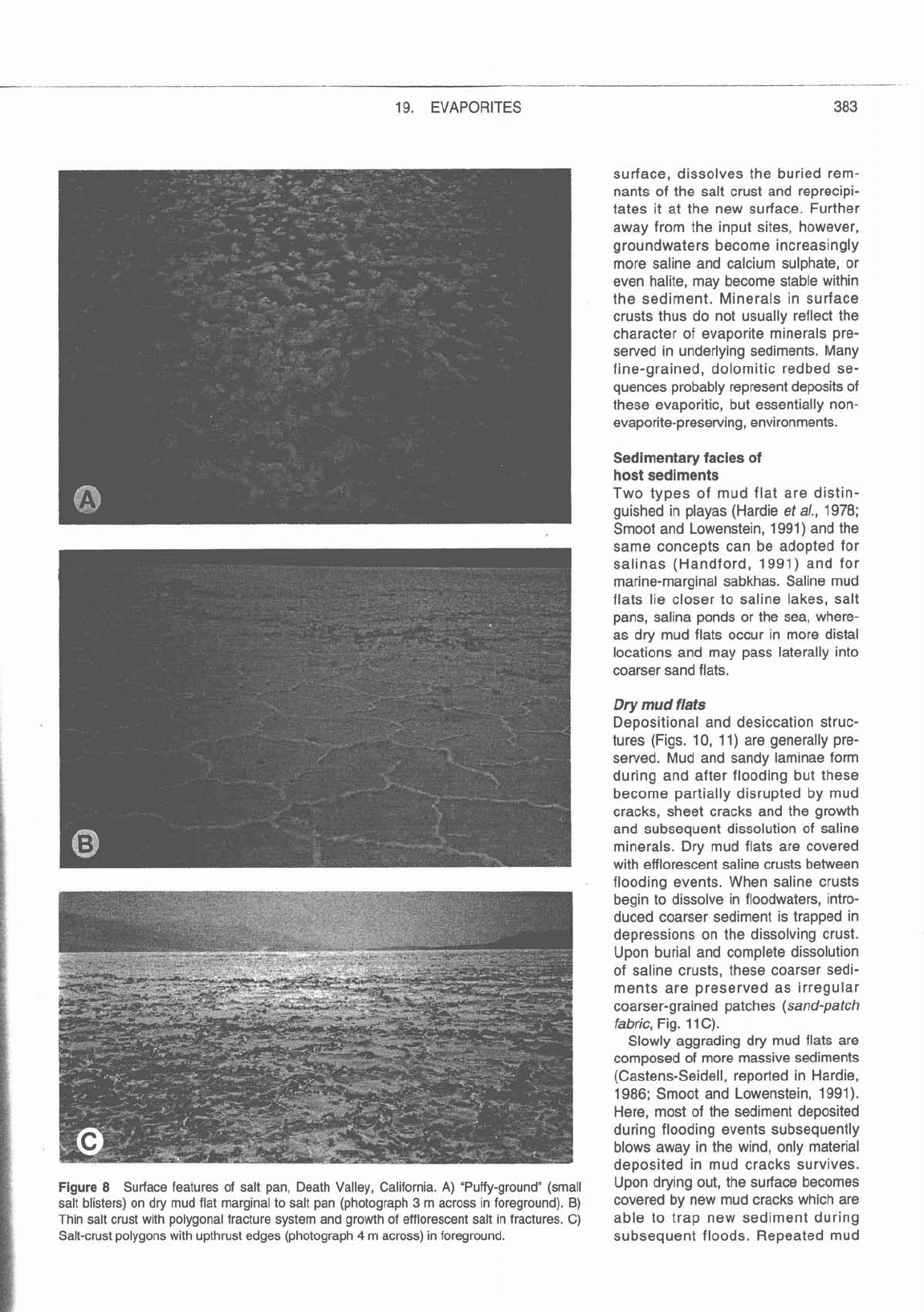
19. EVAPORITES 383
surface, dissolves the buried rem-
nants of the salt crust and
reprecipi-
tates it at the new surface. Further
away from the input sites, however,
groundwaters become increasingly
more saline and calcium sulphate, or
even halite, may become stable within
the sediment. Minerals in surface
crusts thus do not usually reflect the
character of evaporite minerals pre-
served in underlying sediments. Many
fine-grained, dolomitic
redbed se-
quences probably represent deposits of
these evaporitic, but essentially
non-
evaporite-preserving, environments.
Sedimentary facies
of
host sediments
Two types of mud flat are distin-
guished in playas (Hardie et
a/., 1978;
Smoot and Lowenstein, 1991) and the
same concepts can be adopted for
salinas (Handford, 1991) and for
marine-marginal sabkhas. Saline mud
flats lie closer to saline lakes, salt
pans, salina ponds or the sea, where-
as dry mud flats occur in more distal
locations and may pass laterally into
coarser sand flats.
Dry
mud
flats
Depositional and desiccation struc-
tures (Figs. 10, 11) are generally pre-
served. Mud and sandy laminae form
during and after flooding but these
become partially disrupted by mud
cracks, sheet cracks and the growth
and subsequent dissolution of saline
minerals. Dry mud flats are covered
with efflorescent saline crusts between
flooding events. When saline crusts
begin to dissolve in floodwaters, intro-
duced coarser sediment is trapped in
depressions on the dissolving crust.
Upon burial and complete dissolution
of saline crusts, these coarser sedi-
ments are preserved as irregular
coarser-grained patches (sand-patch
fabric, Fig. 1 1 C).
Slowly aggrading dry mud flats are
composed of more massive sediments
(Castens-Seidell, reported in Hardie,
1986; Smoot and Lowenstein, 1991).
Here, most of the sediment deposited
during flooding events subsequently
blows away in the wind, only material
deposited in mud cracks survives.
Figure
8
Surface features of salt pan, Death Valley, California.
A)
"Puffy-ground" (small
Upon drying
Out#
the
surface
salt blisters) on dry mud flat marginal to salt pan (photograph
3
m
across in foreground).
B)
covered by new mud cracks which are
Thin salt crust with polygonal fracture system and growth of efflorescent salt in fractures. C)
able to trap new sediment during
Salt-crust polygons with upthrust edges (photograph
4
m
across) in foreground. subsequent floods. Repeated mud

384 KENDALL
cracking and sediment filling, together
with growth and dissolution of halite
crystals, generates massive
mud-
stones.
Saline
mud
flats
These mud flats are composed of sed-
iments in which lamination and desic-
cation structures have been destroyed
by the growth of abundant
intrasedi-
ment evaporite crystals. Floods cause
partial dissolution of previously precipi-
tated evaporites and sediment col-
lapses into the cavities formed.
Repeated episodes of these pro-
cesses produces a chaotic mix of
evaporite crystals within an
unlarni-
nated mud matrix (Figs.
12,
13A).
Mud
flat evaporite facies
lntrasediment evaporite crystals grow
by incorporating sediment (trapped as
inclusions within the growing crystals),
or displacively, by pushing aside the
sediment, or by both processes
(Fig.
13A). The amount of evaporite
emplaced within sediments varies
enormously (Fig.
12).
Saturation of groundwaters with
respect to calcium and magnesium
carbonates occurs quickly. This
causes precipitation of
1) calcite
cement or caliche layers in
coarse-
grained sediments, such as alluvial fan
sands and gravels surrounding playas,
2)
micron-sized high-Mg calcite and
protodolomite soft muds, or 3)
traver-
tines and pisolitic caliche when precip-
itation occurs at peripheral springs. In
arid coastal settings, seawater also
quickly becomes carbonate saturated
in the intertidal zone, causing forma-
tion of cemented crusts.
lntrasediment gypsum crystals most
commonly exhibit a discoidal
hemi-
pyramidal habit (flattened normal to the
c-axis, Fig. 7A) and may be complexly
twinned to form rosettes (desert roses).
Gypsum grows displacively within
5
4
~i~~~~
9
~~~k~dl~ upthrust polygons,
par-
Figure
10
Recent mud flat sediments. A) Flaser-bedded clastic playa sediment with clay
1
tially
dissolved
to
form
highly irregular,
0.5
drapes
(5
cm coin for scale).
B)
Contorted gypsum and red mud; note truncated gypsum
i
relief. Devil's ~~lf course, ~~~th valley,
layers marking former playa surface
(5
cm coin for scale), Bristol Dry Lake (California);
USA. photo courtesy C.R. Handford.
i
i
i
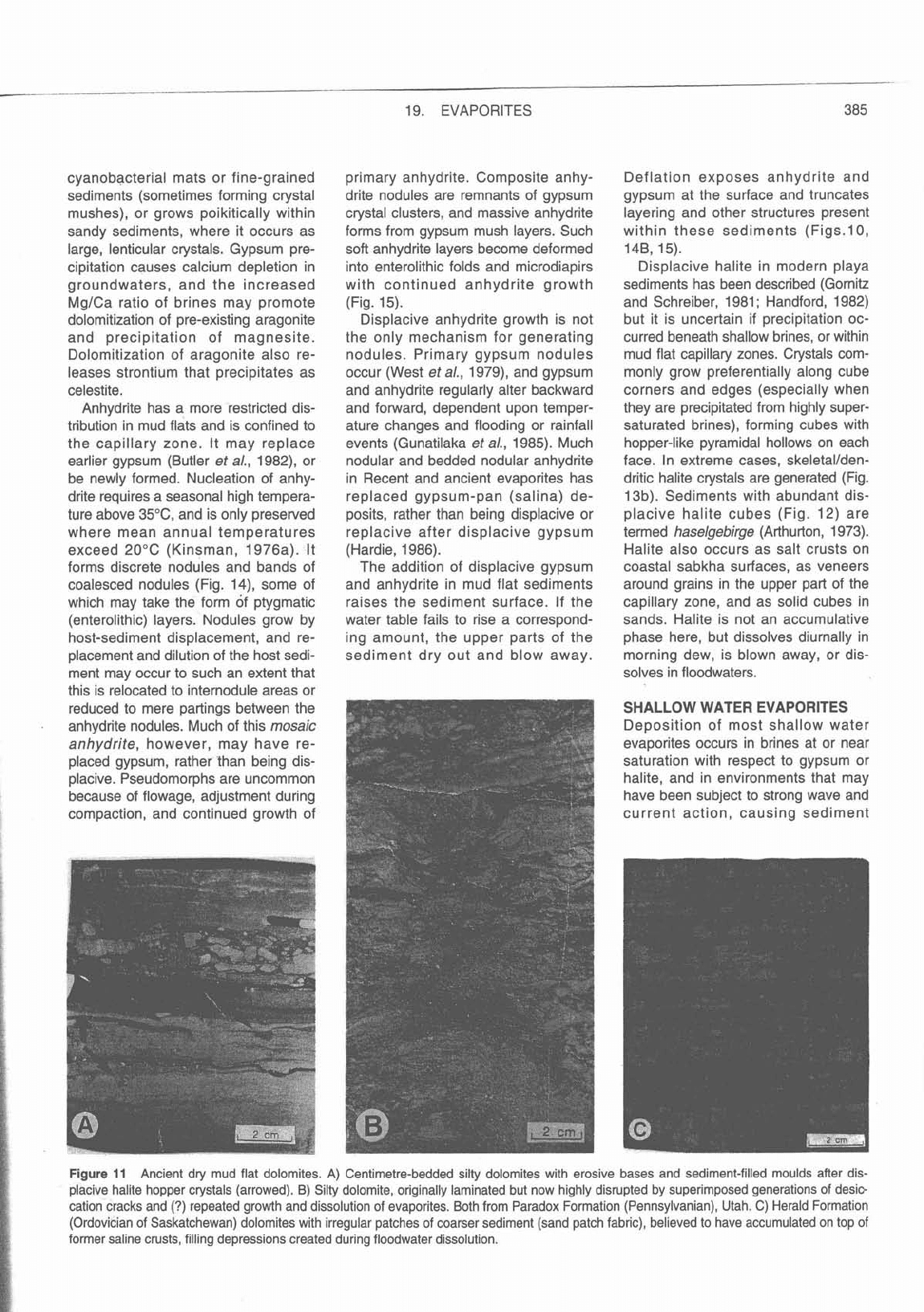
p---
--
19. EVAPORITES 385
cyanobacterial mats or fine-grained
sediments (sometimes forming crystal
mushes), or grows poikitically within
sandy sediments, where it occurs as
large, lenticular crystals. Gypsum pre-
cipitation causes calcium depletion in
groundwaters, and the increased
MgICa ratio of brines may promote
dolomitization of pre-existing aragonite
and precipitation of magnesite.
Dolomitization of aragonite also re-
leases strontium that precipitates as
celestite.
Anhydrite has a more restricted dis-
tribution in mud flats and is confined to
the capillary zone. It may replace
earlier gypsum (Butler
et a/.,
1982), or
be newly formed. Nucleation of anhy-
drite requires a seasonal high tempera-
ture above
35"C, and is only preserved
where mean annual temperatures
exceed
20°C (Kinsman, 1976a). It
forms discrete nodules and bands of
coalesced nodules (Fig.
14), some of
which may take the form of
ptygmatic
(enterolithic) layers. Nodules grow by
host-sediment displacement, and re-
placement and dilution of the host sedi-
ment mav occur to such an extent that
this is relocated to internodule areas or
primary anhydrite. Composite anhy-
drite nodules are remnants of gypsum
crystal clusters, and massive anhydrite
forms from gypsum mush layers. Such
soft anhydrite layers become deformed
into enterolithic folds and microdiapirs
with continued anhydrite growth
(Fig. 15).
Displacive anhydrite growth is not
the only mechanism for generating
nodules. Primary gypsum nodules
occur (West
etal.,
1979), and gypsum
and anhydrite regularly alter backward
and forward, dependent upon temper-
ature changes and flooding or rainfall
events (Gunatilaka
et al.,
1985). Much
nodular and bedded nodular anhydrite
in Recent and ancient evaporites has
replaced gypsum-pan (salina) de-
posits, rather than being displacive or
replacive after displacive gypsum
(Hardie, 1986).
The addition of displacive gypsum
and anhydrite in mud flat sediments
raises the sediment surface. If the
water table fails to rise a correspond-
ing amount, the upper parts of the
sediment dry out and blow away.
Deflation exposes anhydrite and
gypsum at the surface and truncates
layering and other structures present
within these sediments
(Figs.10,
14B, 15).
Displacive halite in modern playa
sediments has been described (Gomitz
and Schreiber, 1981
;
Handford, 1982)
but it is uncertain if precipitation oc-
curred beneath shallow brines, or within
mud flat capillary zones. Crystals com-
monly grow preferentially along cube
corners and edges (especially when
they are precipitated from highly super-
saturated brines), forming cubes with
hopper-like pyramidal hollows on each
face. In extreme cases,
skeletallden-
dritic halite crystals are generated (Fig.
13b). Sediments with abundant dis-
placive halite cubes (Fig. 12) are
termed
haselgebirge
(Arthurton, 1973).
Halite also occurs as salt crusts on
coastal sabkha surfaces, as veneers
around grains in the upper part of the
capillary zone, and as solid cubes in
sands. Halite is not an accumulative
phase here, but dissolves diurnally in
morning dew, is blown away, or dis-
solves in floodwaters.
Figure
11
Ancient dry mud flat dolomites.
A)
Centimetre-bedded silty dolomites with erosive bases and sediment-filled moulds after dis-
placive halite hopper crystals (arrowed). 6) Silty dolomite, originally laminated but now highly disrupted by superimposed generations of desic-
cation cracks and
(?)
repeated growth and dissolution of evaporites. Both from Paradox Formation (Pennsylvanian), Utah. C) Herald Formation
(Ordovician of Saskatchewan) dolomites with irregular patches of coarser sediment (sand patch fabric), believed to have accumulated on top of
former saline crusts, filling depressions created during floodwater dissolution.
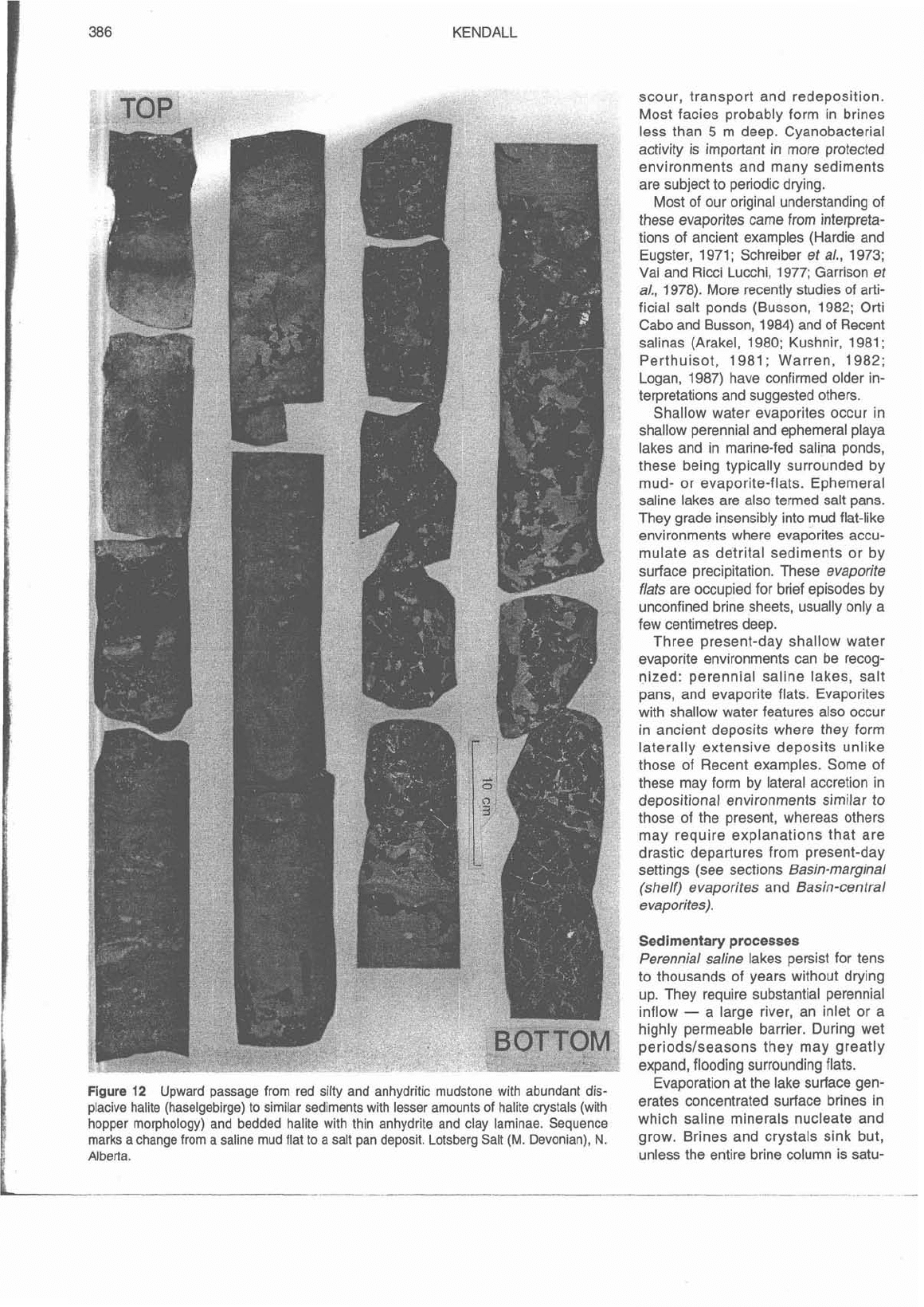
386 KENDALL
scour, transport and redeposition.
Most facies probably form in brines
less than
5
m deep. Cyanobacterial
activity is important in more protected
environments and many sediments
are subject to periodic drying.
Most of our original understanding of
these evaporites came from interpreta-
tions of ancient examples (Hardie and
Eugster, 1971; Schreiber et al., 1973;
Vai and Ricci Lucchi, 1977; Garrison et
a/., 1978). More recently studies of arti-
ficial salt ponds
(Busson, 1982; Orti
Cabo and Busson, 1984) and of Recent
salinas (Arakel, 1980; Kushnir, 1981;
Perthuisot, 1981
;
Warren, 1982;
Logan, 1987) have confirmed older in-
terpretations and suggested others.
Shallow water evaporites occur in
shallow perennial and ephemeral playa
lakes and in marine-fed salina ponds,
these being typically surrounded by
mud- or evaporite-flats. Ephemeral
saline lakes are also termed salt pans.
They grade insensibly into mud flat-like
environments where evaporites accu-
mulate as detrital sediments or by
surface precipitation. These evaporite
flats are occupied for brief episodes by
unconfined brine sheets, usually only a
few centimetres deep.
Three present-day shallow water
evaporite environments can be recog-
nized: perennial saline lakes, salt
pans, and evaporite flats. Evaporites
with shallow water features also occur
in ancient deposits where they form
laterally extensive deposits unlike
those of Recent examples. Some of
these may form by lateral accretion in
depositional environments similar to
those of the present, whereas others
may require explanations that are
drastic departures from present-day
settings (see sections Basin-marginal
(shelf) evaporites and Basin-central
evaporites).
Sedimentary processes
Perennial saline lakes persist for tens
to thousands of years without drying
up. They require substantial perennial
inflow
-
a large river, an inlet or a
highly permeable barrier. During wet
periods/seasons they may greatly
expand, flooding surrounding flats.
Figure
12
Upward passage from red silty and anhydritic mudstone with abundant dis-
Evaporation at the lake surface gen-
placive halite (haselgebirge) to similar sediments with lesser amounts of halite crystals (with
erates
'Oncentrated
surface
brines
in
hopper morphology) and bedded halite with thin anhydrite and clay laminae. Sequence
which saline minerals
and
marks a change from a saline mud flat to a salt pan deposit. Lotsberg Salt
(M.
Devonian),
N.
grow. Brines and crystals sink but,
Alberta.
unless the entire brine column is
satu-
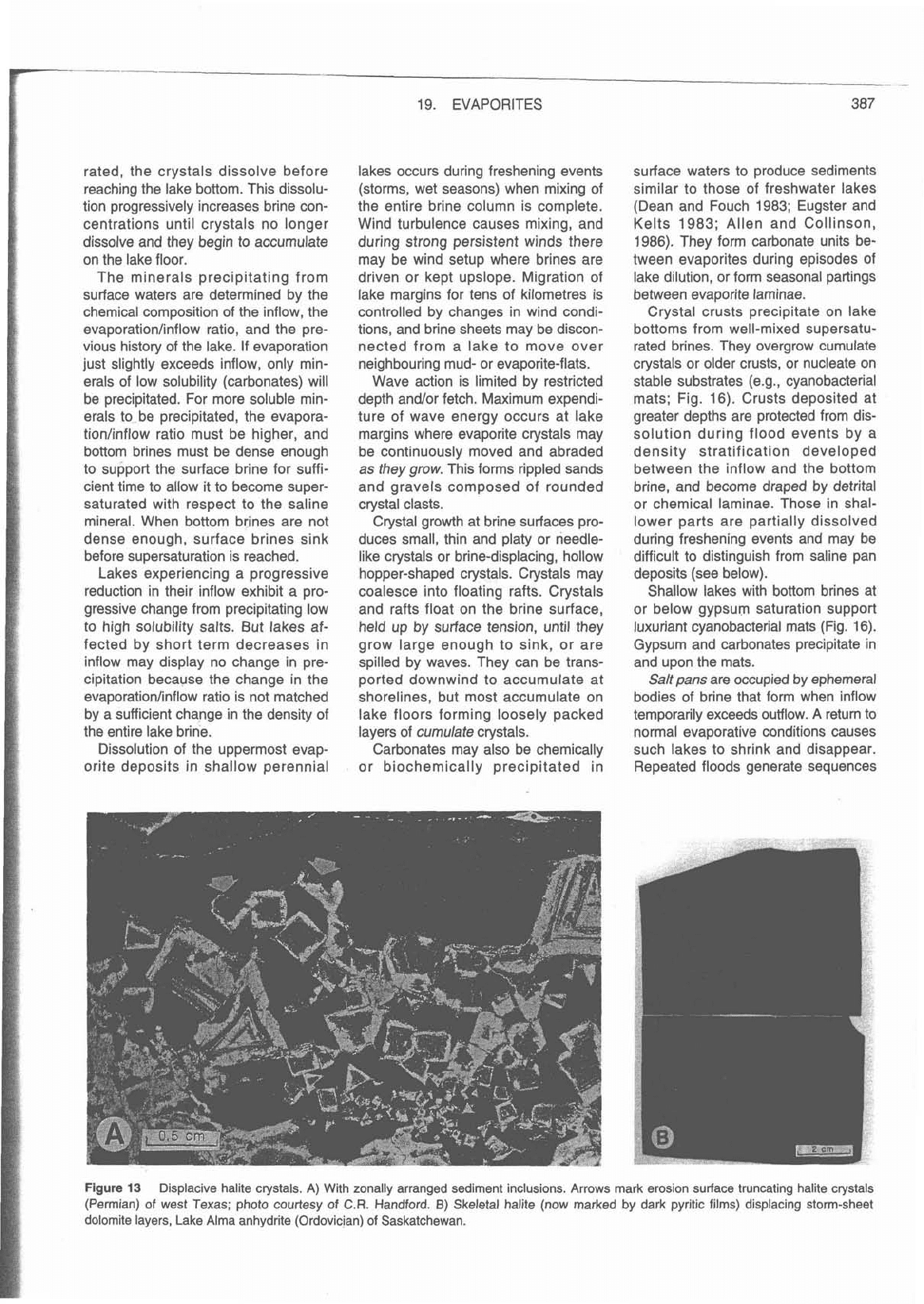
rated, the crystals dissolve before
reaching the lake bottom. This dissolu-
tion progressively increases brine con-
centrations until crystals no longer
dissolve and they begin to accumulate
on the lake floor.
The minerals precipitating from
surface waters are determined by the
chemical composition of the inflow, the
evaporation/inflow ratio, and the pre-
vious history of the lake. If evaporation
just slightly exceeds inflow, only min-
erals of low solubility (carbonates) will
be precipitated. For more soluble min-
erals to be precipitated, the
evapora-
tion/inflow ratio must be higher, and
bottom brines must be dense enough
to support the surface brine for suffi-
cient time to allow it to become super-
saturated with respect to the saline
mineral. When bottom brines are not
dense enough, surface brines sink
before supersaturation is reached.
Lakes experiencing a progressive
reduction in their inflow exhibit a pro-
gressive change from precipitating low
to high solubility salts. But lakes af-
fected by short term decreases in
inflow may display no change in pre-
cipitation because the change in the
evaporation/inflow ratio is not matched
by a sufficient change in the density of
the entire lake brine.
Dissolution of the uppermost evap-
orite deposits in shallow perennial
19.
EVAPORITES
lakes occurs during freshening events
(storms, wet seasons) when mixing of
the entire brine column is complete.
Wind turbulence causes mixing, and
during strong persistent winds there
may be wind setup where brines are
driven or kept
upslope. Migration of
lake margins for tens of kilometres is
controlled by changes in wind condi-
tions, and brine sheets may be discon-
nected from a lake to move over
neighbouring mud- or evaporite-flats.
Wave action is limited by restricted
depth
and/or fetch. Maximum expendi-
ture of wave energy occurs at lake
margins where evaporite crystals may
be continuously moved and abraded
as they
grow.
This forms rippled sands
and gravels composed of rounded
crystal clasts.
Crystal growth at brine surfaces pro-
duces small, thin and platy or needle-
like crystals or brine-displacing, hollow
hopper-shaped crystals. Crystals may
coalesce into floating rafts. Crystals
and rafts float on the brine surface,
held up by surface tension, until they
grow large enough to sink, or are
spilled by waves. They can be trans-
ported downwind to accumulate at
shorelines, but most accumulate on
lake floors forming loosely packed
layers of cumulate crystals.
Carbonates may also be chemically
or biochemically precipitated in
surface waters to produce sediments
similar to those of freshwater lakes
(Dean and Fouch 1983; Eugster and
Kelts 1983; Allen and Collinson,
1986). They form carbonate units be-
tween evaporites during episodes of
lake dilution, or form seasonal partings
between evaporite laminae.
Crystal crusts precipitate on lake
bottoms from well-mixed supersatu-
rated brines. They overgrow cumulate
crystals or older crusts, or nucleate on
stable substrates
(e.g., cyanobacterial
mats; Fig. 16). Crusts deposited at
greater depths are protected from dis-
solution during flood events by a
density stratification developed
between the inflow and the bottom
brine, and become draped by detrital
or chemical laminae. Those in shal-
lower parts are partially dissolved
during freshening events and may be
difficult to distinguish from saline pan
deposits (see below).
Shallow lakes with bottom brines at
or below gypsum saturation support
luxuriant cyanobacterial mats (Fig. 16).
Gypsum and carbonates precipitate in
and upon the mats.
Salt pans are occupied by ephemeral
bodies of brine that form when inflow
temporarily exceeds outflow.
A
retum to
normal evaporative conditions causes
such lakes to shrink and disappear.
Repeated floods generate sequences
Figure
13
Displacive halite crystals.
A)
With zonally arranged sediment inclusions. Arrows
(Permian) of west Texas; photo courtesy
of
C.R.
Handford.
B)
Skeletal halite (now markel
dolomite layers, Lake Alma anhydrite (Ordovician) of Saskatchewan.
mark erosion surface truncating halite crystals
d
by
dark pyritic films) displacing storm-sheet
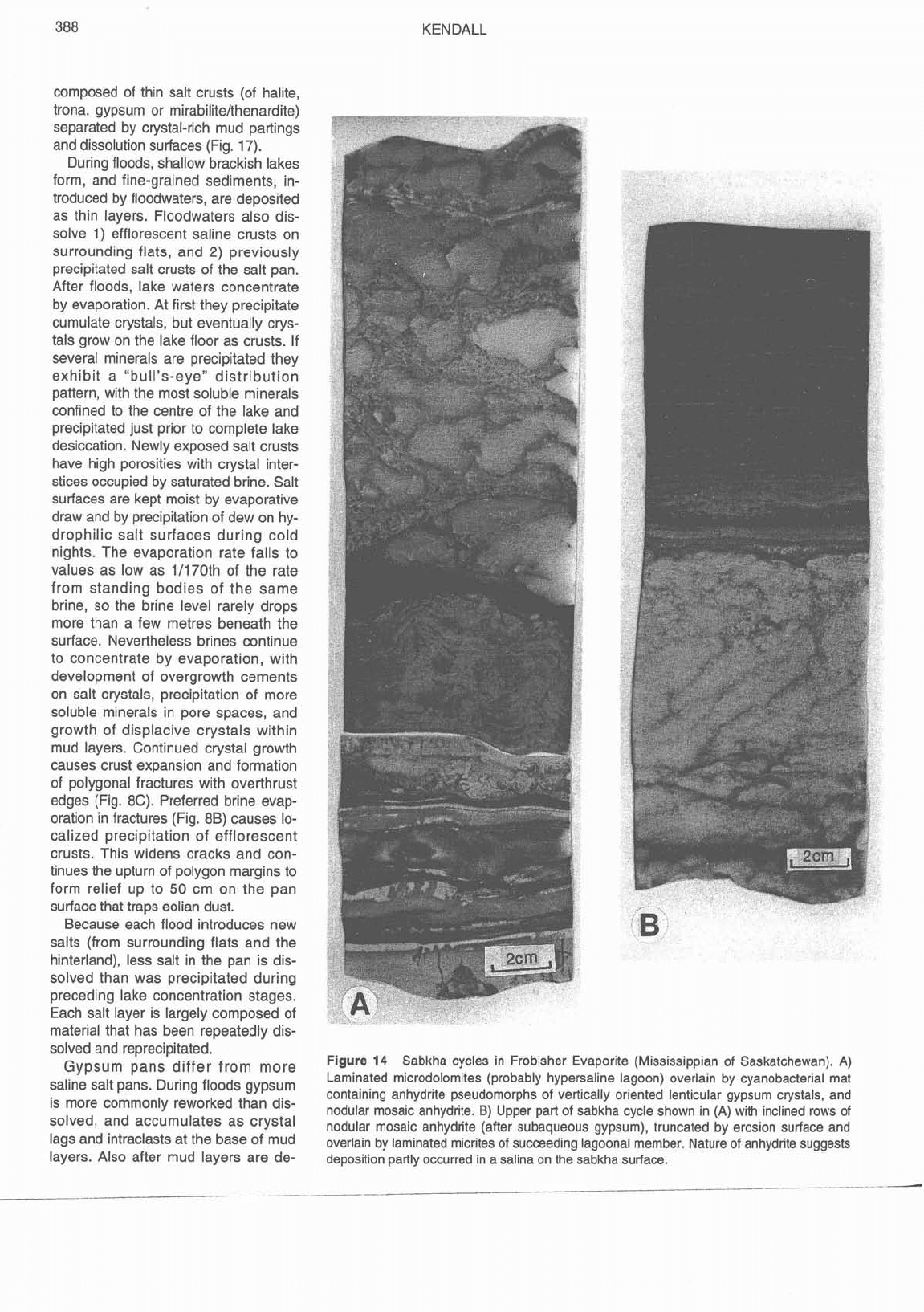
KENDALL
composed of thin salt crusts (of halite,
trona, gypsum or
mirabilitelthenardite)
separated by crystal-rich mud partings
and dissolution surfaces (Fig. 17).
During floods, shallow brackish lakes
form, and fine-grained sediments, in-
troduced by floodwaters, are deposited
as thin layers. Floodwaters also dis-
solve
1)
efflorescent saline crusts on
surrounding flats, and
2)
previously
precipitated salt crusts of the salt pan.
After floods, lake waters concentrate
by evaporation. At first they precipitate
cumulate crystals, but eventually crys-
tals grow on the lake floor as crusts. If
several minerals are precipitated they
exhibit a "bull's-eye" distribution
pattern, with the most soluble minerals
confined to the centre of the lake and
precipitated just prior to complete lake
desiccation. Newly exposed salt crusts
have high porosities with crystal inter-
stices occupied by saturated brine. Salt
surfaces are kept moist by evaporative
draw and by precipitation of dew on hy-
drophilic salt surfaces during cold
nights. The evaporation rate falls to
values as low as 11170th of the rate
from standing bodies of the same
brine, so the brine level rarely drops
more than a few metres beneath the
surface. Nevertheless brines continue
to concentrate by evaporation, with
development of overgrowth cements
on salt crystals, precipitation of more
soluble minerals in pore spaces, and
growth of displacive crystals within
mud layers. Continued crystal growth
causes crust expansion and formation
of polygonal fractures with overthrust
edges (Fig.
8C).
Preferred brine evap-
oration in fractures (Fig.
8B)
causes lo-
calized precipitation of efflorescent
crusts. This widens cracks and con-
tinues the upturn of polygon margins to
form relief up to
50
cm on the pan
surface that traps eolian dust.
Because each flood introduces new
salts (from surrounding flats and the
hinterland), less salt in the pan is dis-
solved than was precipitated during
preceding lake concentration stages.
Each salt layer is largely composed of
material that has been repeatedly dis-
solved and reprecipitated.
Gypsum pans differ from more
saline salt pans. During floods gypsum
is more commonly reworked than dis-
solved, and accumulates as crystal
lags and intraclasts at the base of mud
layers. Also after mud layers are de-
Figure
14
Sabkha cycles in Frobisher Evaporite (Mississippian of Saskatchewan). A)
Laminated microdolomites (probably hypersaline lagoon) overlain by cyanobacterial mat
containing anhydrite pseudomorphs of vertically oriented lenticular gypsum crystals, and
nodular mosaic anhydrite.
B)
Upper part of sabkha cycle shown in (A) with inclined rows of
nodular mosaic anhydrite (after subaqueous gypsum), truncated by erosion surface and
overlain by laminated micrites of succeeding lagoonal member. Nature of anhydrite suggests
deposition partly occurred in a salina on the sabkha surface.
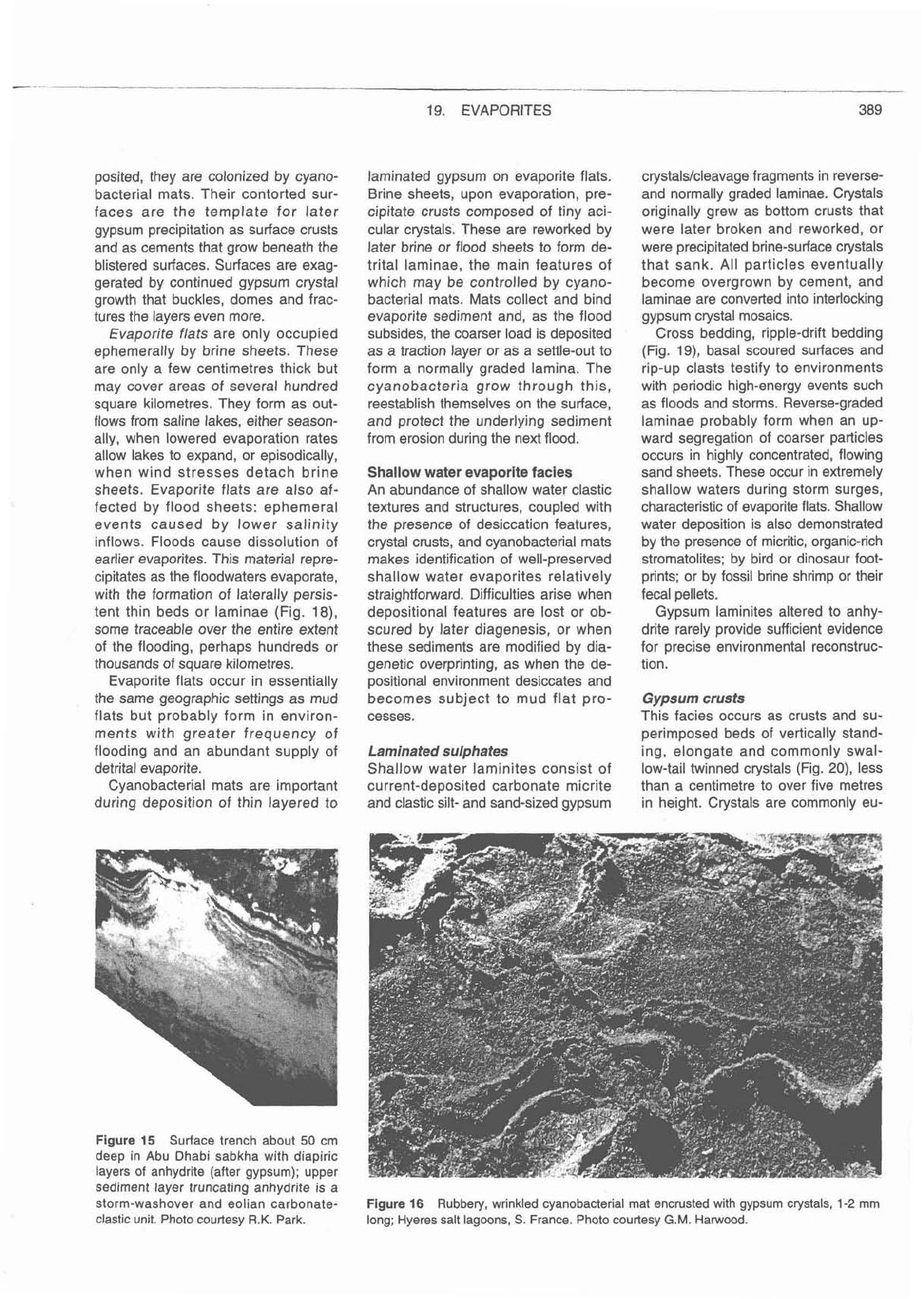
posited, they are colonized by cyano-
bacterial mats. Their contorted sur-
faces are the template for later
gypsum precipitation as surface crusts
and as cements that grow beneath the
blistered surfaces. Surfaces are exag-
gerated by continued gypsum crystal
growth that buckles, domes and frac-
tures the layers even more.
Evaporite flats are only occupied
ephemerally by brine sheets. These
are only a few centimetres thick but
may cover areas of several hundred
square kilometres. They form as out-
flows from saline lakes, either season-
ally, when lowered evaporation rates
allow lakes to expand, or episodically,
when wind stresses detach brine
sheets. Evaporite flats are also af-
fected by flood sheets: ephemeral
events caused by lower salinity
inflows. Floods cause dissolution of
earlier evaporites. This material
repre-
cipitates as the floodwaters evaporate,
with the formation of laterally persis-
tent thin beds or laminae (Fig.
18),
some traceable over the entire extent
of the flooding, perhaps hundreds or
thousands of square kilometres.
Evaporite flats occur in essentially
the same geographic settings as mud
flats but probably form in environ-
ments with greater frequency of
flooding and an abundant supply of
detrital evaporite.
Cyanobacterial mats are important
during deposition of thin layered to
laminated gypsum on evaporite flats.
Brine sheets, upon evaporation, pre-
cipitate crusts composed of tiny
aci-
cular crystals. These are reworked by
later brine or flood sheets to form
de-
trital laminae, the main features of
which may be controlled by cyano-
bacterial mats. Mats collect and bind
evaporite sediment and, as the flood
subsides, the coarser load is deposited
as a traction layer or as a settle-out to
form a normally graded lamina. The
cyanobacteria grow through this,
reestablish themselves on the surface,
and protect the underlying sediment
from erosion during the next flood.
Shallow water evaporite facies
An abundance of shallow water clastic
textures and structures, coupled with
the presence of desiccation features,
crystal crusts, and cyanobacterial mats
makes identification of well-preserved
shallow water evaporites relatively
straightforward. Difficulties arise when
depositional features are lost or ob-
scured by later diagenesis, or when
these sediments are modified by
dia-
genetic overprinting, as when the de-
positional environment desiccates and
becomes subject to mud flat pro-
cesses.
Laminated sulphates
Shallow water laminites consist of
current-deposited carbonate micrite
and clastic silt- and sand-sized gypsum
crystals/cleavage fragments in reverse-
and normally graded laminae. Crystals
originally grew as bottom crusts that
were later broken and reworked, or
were precipitated brine-surface crystals
that sank. All particles eventually
become overgrown by cement, and
laminae are converted into interlocking
gypsum crystal mosaics.
Cross bedding, ripple-drift bedding
(Fig.
19),
basal scoured surfaces and
rip-up clasts testify to environments
with periodic high-energy events such
as floods and storms. Reverse-graded
laminae probably form when an up-
ward segregation of coarser particles
occurs in highly concentrated, flowing
sand sheets. These occur in extremely
shallow waters during storm surges,
characteristic of evaporite flats. Shallow
water deposition is also demonstrated
by the presence of micritic, organic-rich
stromatolites; by bird or dinosaur foot-
prints; or by fossil brine shrimp or their
fecal pellets.
Gypsum laminites altered to
anhy-
drite rarely provide sufficient evidence
for precise environmental reconstruc-
tion.
Gypsum crusts
This facies occurs as crusts and su-
perimposed beds of vertically stand-
ing, elongate and commonly swal-
low-tail twinned crystals (Fig.
20),
less
than a centimetre to over five metres
in height. Crystals are commonly
eu-
Figure
15 Surface trench about
50
cm
deep in Abu Dhabi sabkha with diapiric
layers of anhydrite (after gypsum); upper
sediment layer truncating anhydrite
is a
storm-washover and eolian carbonate-
Figure 16
Rubbery, wrinkled cyanobacterial mat encrusted with gypsum crystals,
1-2
rnm
clastic unit. Photo courtesy
R.K.
Park.
long; Hyeres salt lagoons,
S.
France. Photo courtesy
G.M.
Harwood.
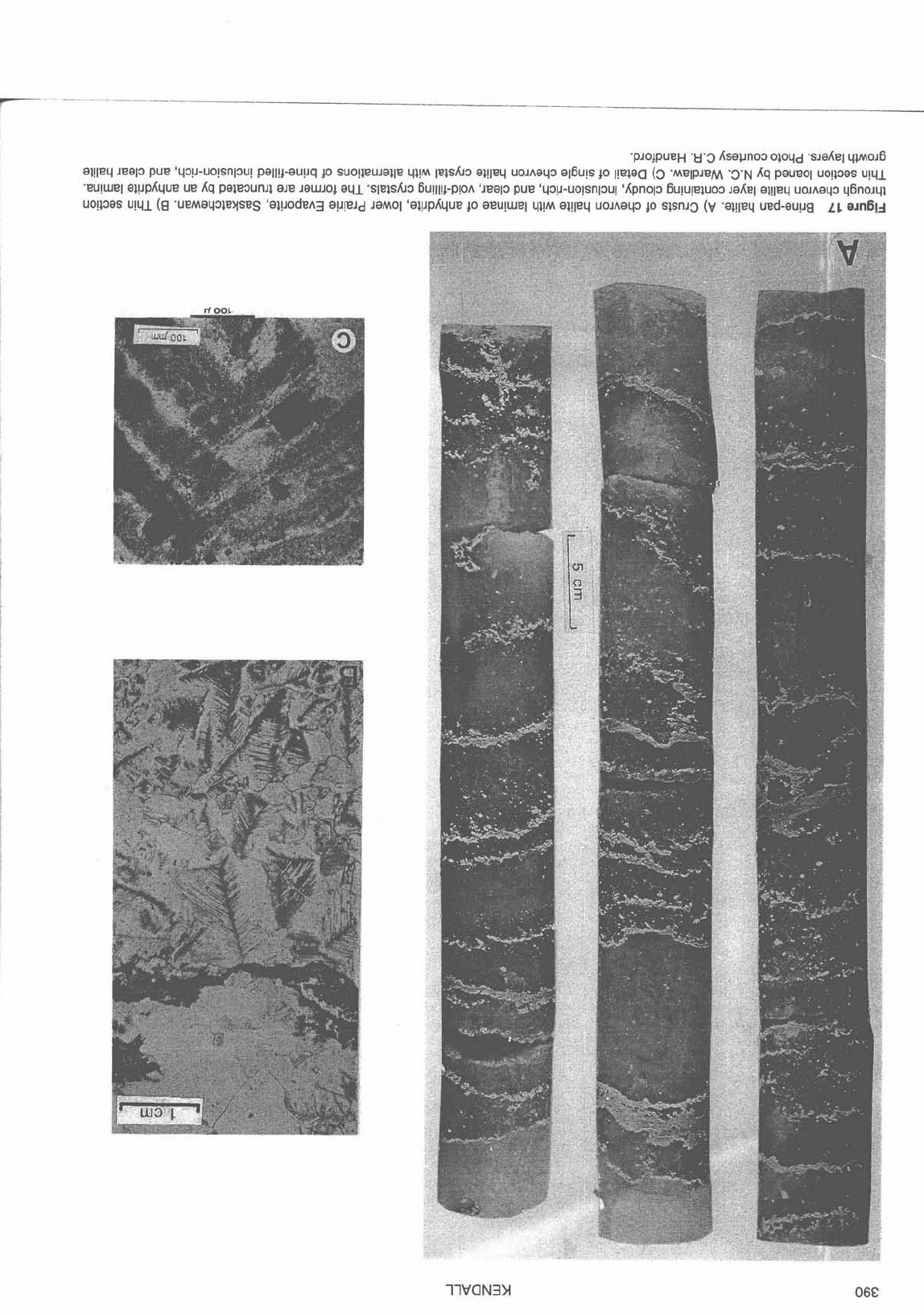
'pJO4pUeH 'H.3 Asaunoo OlOqd '~Jdel 41~0~6
al!leq Jeep pue 'qo!~-uo!sn~ou! pall!k-au!Jq
40
suo!ieuJalle ~I!M ~epho al!Ieq uoJAaqo a16u!s
40
I!elaa (3
'MEIPJEM
'3'~
Aq paueol uo!pas u!ql
.eu!Luel al!~pAque ue Aq paleounJ1 ale JawJoj aql 'slelsh3 Gu!~~!~-P!oA 'Jealo pue 'qo!~-uo!snpu! 'Apnop 6u!u!eluoo ~aAel al!le4 uo~~aq:, q6no~ql
uopas u!q1
(a
.ueMayoleyses 'al!~ode~3 a!J!eJd JaMol 'al!~pAque
40
aeu!wal qi!~ al!leq uo~~aqo lo stsn~=)
(y
.ai!leq ued-au!~g
LC
arn6ij
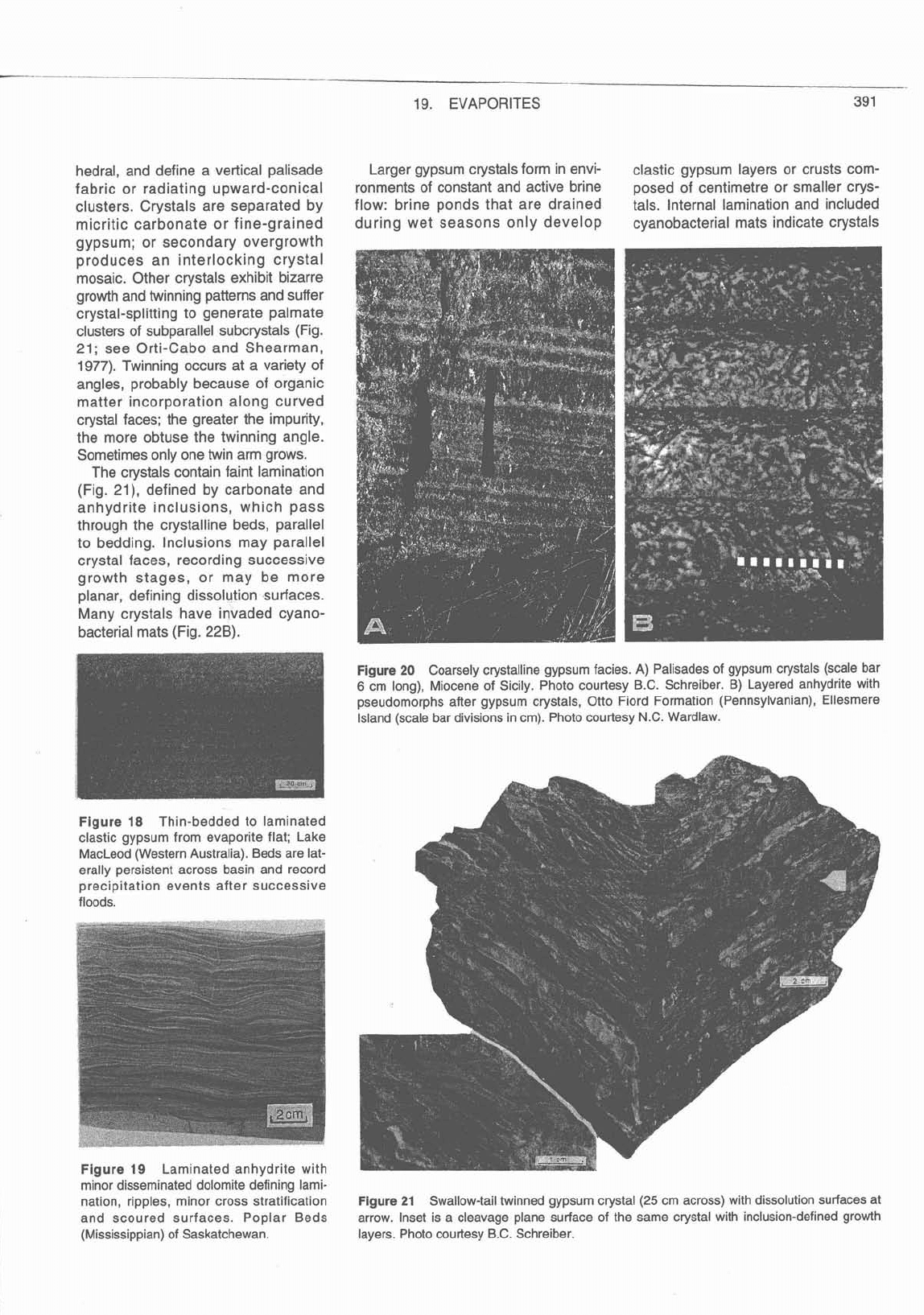
hedral, and define a vertical palisade
Larger gypsum crystals form in
envi-
clastic gypsum layers or crusts com-
fabric or radiating upward-conical
ronments of constant and active brine
posed of centimetre or smaller crys-
clusters. Crystals are separated by
flow: brine ponds that are drained
tals. Internal lamination and included
micritic carbonate or fine-grained
during wet seasons only develop
cyanobacterial mats indicate crystals
gypsum; or secondary overgrowth
produces an interlocking crystal
mosaic. Other crystals exhibit bizarre
growth and twinning patterns and suffer
crystal-splitting to generate palmate
clusters of subparallel subcrystals (Fig.
21;
see Orti-Cabo and Shearman,
1977). Twinning occurs at a variety of
angles, probably because of organic
matter incorporation along curved
crystal faces; the greater the impurity,
the more obtuse the twinning angle.
Sometimes only one twin arm grows.
The crystals contain faint lamination
(Fig.
21), defined by carbonate and
anhydrite inclusions, which pass
through the crystalline beds, parallel
to bedding. Inclusions may parallel
crystal faces, recording successive
growth stages, or may be more
planar, defining dissolution surfaces.
Many crystals have invaded
cyano-
bacterial mats (Fig. 22B).
Figure 20 Coarsely crystalline gypsum facies. A) Palisades of gypsum crystals (scale bar
6
cm long), Miocene of Sicily. Photo courtesy
B.C.
Schreiber.
B)
Layered anhydrite with
pseudomorphs after gypsum crystals, Otto Fiord Formation (Pennsylvanian), Ellesmere
Island (scale bar divisions in cm). Photo courtesy N.C.
Wardlaw.
Figure
18
Thin-bedded to laminated
clastic gypsum from evaporite flat; Lake
MacLeod (Western Australia). Beds are lat-
erally persistent across basin and record
precipitation events after successive
floods.
Figure
19
Laminated anhydrite with
minor disseminated dolomite defining lami-
nation, ripples, minor cross stratification
Figure
21
Swallow-tail twinned gypsum crystal (25 cm across) with dissolution surfaces at
and scoured surfaces. Poplar Beds arrow. Inset is a cleavage plane surface of the same crystal with inclusion-defined growth
(Mississippian) of Saskatchewan.
layers. Photo courtesy B.C. Schreiber.
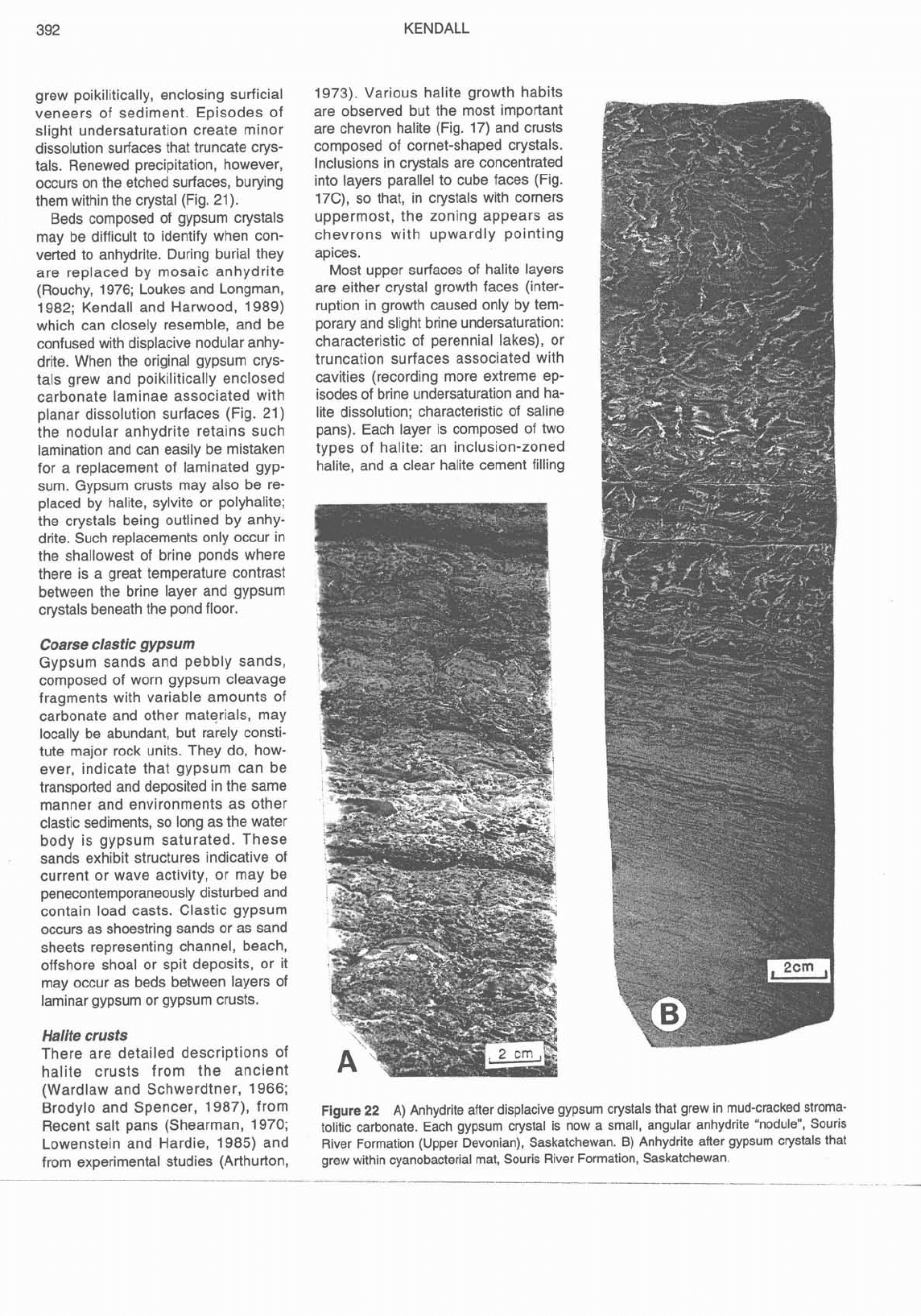
392 KENDALL
grew poikilitically, enclosing surficial
veneers of sediment. Episodes of
slight undersaturation create minor
dissolution surfaces that truncate crys-
tals. Renewed precipitation, however,
occurs on the etched surfaces, burying
them within the crystal (Fig. 21).
Beds composed of gypsum crystals
may be difficult to identify when con-
verted to anhydrite. During burial they
are replaced by mosaic anhydrite
(Rouchy, 1976; Loukes and
Longman,
1982; Kendall and Harwood, 1989)
which can closely resemble, and be
confused with displacive nodular anhy-
drite. When the original gypsum crys-
tals grew and poikilitically enclosed
carbonate laminae associated with
planar dissolution surfaces (Fig. 21)
the nodular anhydrite retains such
lamination and can easily be mistaken
for a replacement of laminated gyp-
sum. Gypsum crusts may also be re-
placed by halite, sylvite or
polyhalite;
the crystals being outlined by anhy-
drite. Such replacements only occur in
the shallowest of brine ponds where
there is a great temperature contrast
between the brine layer and gypsum
crystals beneath the pond floor.
Coarse clastic gypsum
Gypsum sands and pebbly sands,
composed of worn gypsum cleavage
fragments with variable amounts of
carbonate and other materials, may
locally be abundant, but rarely consti-
tute major rock units. They do, how-
ever, indicate that gypsum can be
transported and deposited in the same
manner and environments as other
clastic sediments, so long as the water
body is gypsum saturated. These
sands exhibit structures indicative of
current or wave activity, or may be
penecontemporaneously disturbed and
contain load casts. Clastic gypsum
occurs as shoestring sands or as sand
sheets representing channel, beach,
offshore shoal or spit deposits, or it
may occur as beds between layers of
laminar gypsum or gypsum crusts.
Halite crusts
There are detailed descriptions of
halite crusts from the ancient
1973). Various halite growth habits
are observed but the most important
are chevron halite (Fig. 17) and crusts
composed of cornet-shaped crystals.
Inclusions in crystals are concentrated
into layers parallel to cube faces (Fig.
17C), so that, in crystals with corners
uppermost, the zoning appears as
chevrons with upwardly pointing
apices.
Most upper surfaces of halite layers
are either crystal growth faces (inter-
ruption in growth caused only by tem-
porary and slight brine undersaturation:
characteristic of perennial lakes), or
truncation surfaces associated with
cavities (recording more extreme ep-
isodes of brine undersaturation and ha-
lite dissolution; characteristic of saline
pans). Each layer is composed of two
types of halite: an inclusion-zoned
halite, and a clear halite cement filling
(Wardlaw and Schwerdtner, 1966;
BrOd~10
and Spencer$ 987)9
Figure
22
A) Anhydrite after displacive gypsum crystals that grew in mud-cracked stroma-
Recent salt pans (Shearman, 1970;
tolitic carbonate. Each gypsum crystal is now a small, angular anhydrite "nodule", Souris
Lowenstein and Hardie, 1985) and
River Formation (Upper Devonian), Saskatchewan.
B)
Anhydrite after gypsum crystals that
from experimental studies (Arthurton,
grew within cyanobacterial mat,
Souris River Formation, Saskatchewan.
